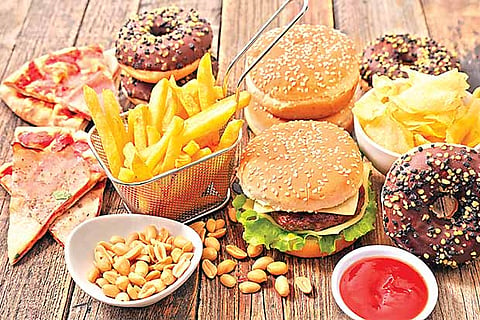

The findings of the study were published in the journal 'JAMA'. The calories that children and adolescents consumed from ultra-processed foods jumped from 61 per cent to 67 per cent of total caloric intake from 1999 to 2018. The study analysed dietary intake from 33,795 children and adolescents nationwide.
"Some whole-grain breads and dairy foods are ultra-processed, and they're healthier than other ultra-processed foods. Processing can keep food fresher longer, allows for food fortification and enrichment, and enhances consumer convenience," said senior and corresponding author Fang Fang Zhang, a nutrition epidemiologist at the Friedman School.
"But many ultra-processed foods are less healthy, with more sugar and salt, and less fibre, than unprocessed and minimally processed foods, and the increase in their consumption by children and teenagers is concerning," added Zhang.
The largest spike in calories came from such ready-to-eat or ready-to-heat dishes as takeout and frozen pizza and burgers: from 2.2 per cent to 11.2 per cent of calories. The second-largest spike in calories came from packaged sweet snacks and desserts, the consumption of which grew from 10.6 per cent to 12.9 per cent. There was a larger increase in the consumption of ultra-processed foods among non-Hispanic Blacks (10.3 per cent) and Mexican Americans (7.6 per cent) than non-Hispanic Whites (5.2 per cent). Trends in other racial/ethnic groups were not assessed due to a lack of sufficient data that allow for nationally representative estimates across survey cycles.
There were no statistically significant differences in the overall findings by parental education and family income. "The lack of disparities based on parental education and family income indicates that ultra-processed foods are pervasive in children's diets," said Zhang.
"This finding supports the need for researchers to track trends in food consumption more fully, taking into account consumption of ultra-processed foods," explained Zhang.
Over the study period, calories from often healthier unprocessed or minimally processed foods decreased from 28.8 per cent to 23.5 per cent. The remaining percentage of calories came from moderately processed foods such as cheese and canned fruits and vegetables, and consumer-added flavour enhancers such as sugar, honey, maple syrup, and butter. There was good news: Calories from sugar-sweetened beverages dropped from 10.8 per cent to 5.3 per cent of overall calories, a 51 per cent drop.
"This finding shows the benefits of the concerted campaign over the past few years to reduce overall consumption of sugary drinks," said Zhang.
"We need to mobilise the same energy and level of commitment when it comes to other unhealthy ultra-processed foods such as cakes, cookies, doughnuts and brownies," continued Zhang.
"In additional analyses, we compared the composition of ultra-processed foods to non-ultra processed foods using data from the 2017-2018 period," said the study's first author, Lu Wang, a postdoctoral fellow at the Friedman School.
"We found that ultra-processed foods contain a substantially higher percentage of calories from carbohydrates and added sugars, and higher levels of sodium, but also had less fibre and a lower percentage of calories from protein," observed Wang.
"Food processing is an often-overlooked dimension in nutrition research. We may need to consider that ultra processing of some foods may be associated with health risks, independent of the poor nutrient profile of ultra-processed foods generally," concluded Zhang.
Ultra-processed foods
Ultra-processed foods are ready-to-eat or ready-to-heat items often high in added sugar, sodium, and carbohydrates and low in fibre, protein, vitamins, and minerals. They typically contain added sugars, hydrogenated oils, and flavour enhancers. Examples include packaged sweet snacks and desserts, sugary breakfast cereals, french fries, fast food burgers, and some lunchmeats such as bologna and salami. When consumed in excess, these foods are linked with diabetes, obesity, and other serious medical conditions, such as certain cancers.
Methodology
This new study is part of a series led by Friedman School researchers investigating patterns and trends in diet quality among US adults and children. The study characterised trends in ultra-processed food consumption among US children aged 2-19 years from 1999 to 2018, overall and among population subgroups, using data from 10 consecutive cycles of the National Health and Nutrition Examination Survey (NHANES). It further assessed major ultra-processed food subgroups consumed by US children in the latest cycle of NHANES (2017-2018) and associated nutrient profiles. The average age of participants was 10.7 years and was roughly equally divided between boys and girls. It relied on 24-hour dietary recall interviews conducted by trained personnel; older children and teens directly reported on the foods they ate while parents and caregivers did so for younger children. The percentage of calories consumed by participants was determined using the NOVA food classification system developed by researchers at the University of Sao Paulo, Brazil.
Visit news.dtnext.in to explore our interactive epaper!
Click here for Android